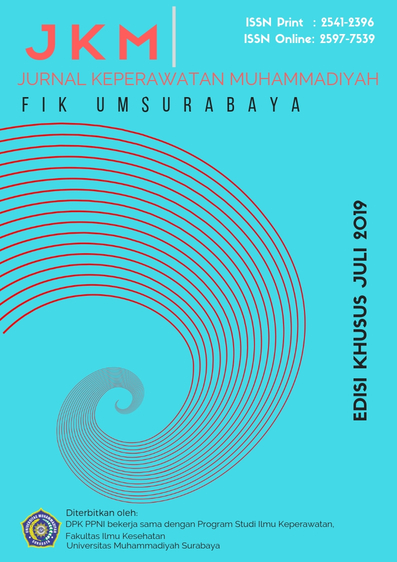Analisis Ekonomi Pencegahan Pressure Injury (Oral Nutrition, Repositioning, Skin Protection): Literature Review
DOI:
https://doi.org/10.30651/jkm.v4i2.2202Keywords:
Prevention, Oral nutrition, Repositioning, Skin protection, Pressure injuryAbstract
Introduction: Pressure injury is a major problem in patients with long bed rest. At least the pressure injury has an impact on patients, families and health workers, which is one of the causes of morbidity in patients both physically and mentally, resulting in high health expenses, and an increase in nurses' workload. So it is necessary to take precautionary measures that include oral nutrition, repositioning and skin protection that are fairly expensive. This literature review wants to describe the amount of costs needed to prevent pressure injury.
Method: Data is collected since 2017, using 3 databases (Pubmed, science direct, goggle schollar) where the literature used is published internationally, additional references are taken from the bibliography of all relevant articles. Inclusion criteria refer to the modality of prevention of injury injury and the costs required.
Result: The average cost required for oral nutrition is AU $ 33,687 compared to standard care, namely AU $ 425 in 1 year, the total cost incurred due to pressure injury was $ 96,552 for 10 months, with an average of $ 9655 / month, and use of skin protection assessed most cost effective.
Conclusion: Although it is considered relatively expensive, prevention of pressure injury provides an economic benefit of 87% compared to treatment
References
Amir, Y., Lohrmann, C., Halfens, R. J. G., & Schols, J. M. G. A. (2016). Pressure ulcers in four Indonesian hospitals: prevalence, patient characteristics, ulcer characteristics, prevention and treatment. International Wound Journal, 14(1), 184–193. https://doi.org/10.1111/iwj.12580
Bennett, G., Dealey, C., & Posnett, J. (2004). The cost of pressure ulcers in the UK. Age and Ageing, 33(3), 230–235. https://doi.org/10.1093/ageing/afh086
Bergstrom, N., Horn, S. D., Rapp, M. P., Stern, A., Barrett, R., & Watkiss, M. (2013). Turning for ulcer ReductioN: A Multisite randomized clinical trial in nursing homes. Journal of the American Geriatrics Society, 61(10), 1705–1713. https://doi.org/10.1111/jgs.12440
Bergstrom, N., Horn, S. D., Rapp, M., Stern, A., Barrett, R., Watkiss, M., & Krahn, M. (2014). Preventing Pressure Ulcers: A Multisite Randomized Controlled Trial in Nursing Homes. Ontario Health Quality Ontario, 14(11), 1–32.
Braden, B., & Bergstrom, N. (1987). A Conceptual Schema for the Study of the Etiology of Pressure Sores, 25(3).
Defloor, T., Bacquer, D. De, & Grypdonck, M. H. F. (2005). The effect of various combinations of turning and pressure reducing devices on the incidence of pressure ulcers. International Journal of Nursing Studies, 42(1), 37–46. https://doi.org/10.1016/j.ijnurstu.2004.05.013
Demarre, L., Verhaeghe, S., Annemans, L., Hecke, A. Van, Grypdonck, M., & Beeckman, D. (2015). The cost of pressure ulcer prevention and treatment in hospitals and nursing homes in Flanders : A cost-of-illness study. International Journal of Nursing Studies, 14. https://doi.org/10.1016/j.ijnurstu.2015.03.005
Edger, M. (2017). Effect of a Patient-Repositioning Device in an Intensive Care Unit On Hospital-Acquired Pressure Injury Occurences and Cost A Before-After Study. J Wound Continence Nurs, 44(June), 236–240. https://doi.org/10.1097/WON.0000000000000328
Manzano, F., Colmenero, M., Pérez-Pérez, A. M., Roldán, D., Jiménez-Quintana, M. del M., Mañas, M. R., … Fernández-Mondéjar, E. (2014). Comparison of two repositioning schedules for the prevention of pressure ulcers in patients on mechanical ventilation with alternating pressure air mattresses. Intensive Care Medicine, 40(11), 1679–1687. https://doi.org/10.1007/s00134-014-3424-3
Moore, Z., Cowman, S., & Conroy, R. M. (2011). A randomised controlled clinical trial of repositioning, using the 30° tilt, for the prevention of pressure ulcers. Journal of Clinical Nursing, 20(17–18), 2633–2644. https://doi.org/10.1111/j.1365-2702.2011.03736.x
Nguyen, K., Chaboyer, W., & Whitty, J. A. (2015). Pressure injury in Australian public hospitals : a cost-of-illness study. Australian Health Review, 329–336.
NPUAP. (2016). NPUAP Pressure Injury Stages. Retrieved January 1, 2017, from http://www.npuap.org/resources/educational-and-clinical-resources/npuap-pressure-injury-stages/
Pan Pacific. (2012). Pan Pacific Clinical Practice Guideline for the Prevention and Management of Pressure Injury. Universitas Stuttgart. Singapore.
Paulden, M., Bergstrom, N., Horn, S. D., Rapp, M. P., & Barrett, R. (2014). Turning for Ulcer Reduction ( TURN ) Study : An Economic Analysis. Ontario Health Technology Assesment Series, 14(12), 1–24.
Pham, B., Stern, A., Chen, W., Sander, B., Baptiste, J., Thein, H. hla, … Krahn, M. (2015). Preventing Pressure Ulcers in Long-term Care, A cost-effectiveness Analysis. Health Care Reform, 171(20), 1839–1847. https://doi.org/10.1001/archinternmed.2011.473
Spilsbury, K., Nelson, A., Cullum, N., Iglesias, C., Nixon, J., & Mason, S. (2007). Pressure ulcers and their treatment and effect on quality of life: Hospital inpatient perspectives. https://doi.org/10.1111/j.1365-2648.2006.04140.x
Tuffaha, H. W., Roberts, S., Chaboyer, W., Gordon, L. G., & Scuffham, P. A. (2016). Cost-effectiveness Analysis of Nutritional Support for the Prevention of Pressure Ulcers in High-Risk Hospitalized Patients. Advance in Skin & Wound Care, (June), 261–267.
VanGilder, C., Lachenbruch, C., Algrim-Boyle, C., & Meyer, S. (2017). The International Pressure Ulcer PrevalenceTM Survey: 2006-2015 A 10-Year Pressure Injury Prevalence and Demographic Trend Analysis by Care Setting. Journal of Wound, Ostomy and Continence Nursing, 44(1), 1. https://doi.org/10.1097/WON.0000000000000292
Downloads
Published
Issue
Section
License
- Penulis tetap memegang hak atas karyanya dan memberikan hak publikasi pertama kepada jurnal ini yang secara simultan karya tersebut dilisensikan di bawah:Â Creative Commons Attribution-ShareAlike 4.0 International (CC BY-SA 4.0)













